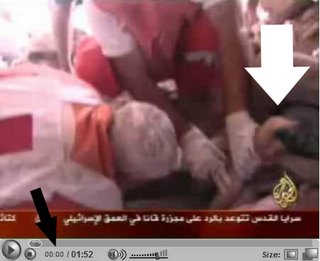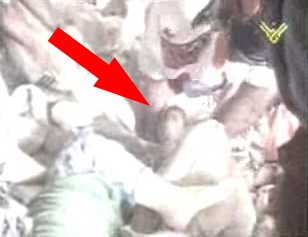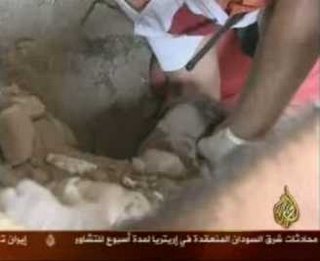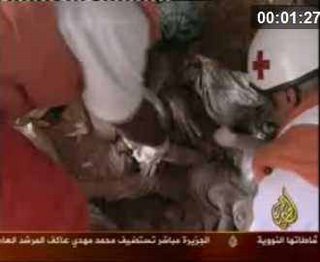Given the way the UN troops are deployed, standing around on the veranda of the wrecked house, with apparently no particular direction or urgency to their mission, it is perhaps not untoward to speculate that they have been there some time - on the basis that the immediate-response medical teams might have been actively engaged in the relief effort. Possibly, therefore, the discovery of baby Hashem may not have occurred until around 12 midday, or even later.
In that we calculate, from shadow analysis, that the bulk of the casualties found in the early phase of the relief effort were evacuated around 9 am in the morning - that being roughly the timing of the "camera runs" conducted by "Green Helmet" and "White Tee-shirt" - there is a possibility that as much as three hours or more elapsed between their discovery and that of the body of baby Hashem.
The problem is that this does not seem to fit with the account of the relief effort by Tim Butcher in The Daily Telegraph of 31 July (We can discount the narrative of Kathy Gannon as being irredemably flawed). He writes:
When ambulance crews arrived from Tyre, bravely covering roads on which they have been attacked in recent days, they began the grimmest search and rescue task, but without any real chance of rescue.From this account, the indications are that baby Hashem's body was found with others, and not separately as the photographic record would appear to indicate. The suspicion arises, therefore, that the body, after its initial discovery, was held back for the staged photo-shoots that we have examined.
They found limbs sticking from a muddle of broken concrete and mattresses soaked with blood attracting the busy attention of swarming flies. For a few hours the more wreckage they moved the more bodies they found.
In one section they found 12 small corpses, all children, among them tiny Abbas.
Their bodies showed few cuts or scratches. It was as if they had simply drowned in a wave of soil and cement dust that overwhelmed them in an instant.
 In exploring this possibility, we have examined all the relevant photographic and video records available to us and, despite our suspicions remaining, the study has been inconclusive.
In exploring this possibility, we have examined all the relevant photographic and video records available to us and, despite our suspicions remaining, the study has been inconclusive.In rough chronological sequence, our study started with the Aljazeera channel footage. There, we saw presenter Mazen Ibrahim commenting on the coverage of the Qana "massacre" in western media. The opening sequence of the film accompanying his commentary showed numerous Red Cross workers moving bodies out of the wreckage, from a pile in which they are heaped. And, in the first second of the sequence, fleetingly visible is a worker lifting up the body of what appeared to be a baby.
 Identifying this figure has presented us with considerable problems. We felt it could be baby Hashem, the only baby to be recovered from the site and the video record certainly meshed with the Butcher account. Then, further indications come from the Al Manar video which, like the Aljazeera film, covered the early recovery scenes inside the basement. This frame (right) shows the same location, but from a different angle. The Red Cross worker is digging down into the debris, apparently finding something buried there. The focus of his attention is indicated by the arrow.
Identifying this figure has presented us with considerable problems. We felt it could be baby Hashem, the only baby to be recovered from the site and the video record certainly meshed with the Butcher account. Then, further indications come from the Al Manar video which, like the Aljazeera film, covered the early recovery scenes inside the basement. This frame (right) shows the same location, but from a different angle. The Red Cross worker is digging down into the debris, apparently finding something buried there. The focus of his attention is indicated by the arrow. This activity apparently attracts the attention of the cameraman, who moves closer to the scene, saturating the local area with light, for which he does not compensate - hence the "white-out" effect on this frame. But clearly, if fleetingly becomes visible the head of a very small child or baby. This can be seen for several seconds until the worker bends over the figure and it is lost to sight, whence the filming of this scene stops. We do not see the figure lifted out from the debris in this sequence.
This activity apparently attracts the attention of the cameraman, who moves closer to the scene, saturating the local area with light, for which he does not compensate - hence the "white-out" effect on this frame. But clearly, if fleetingly becomes visible the head of a very small child or baby. This can be seen for several seconds until the worker bends over the figure and it is lost to sight, whence the filming of this scene stops. We do not see the figure lifted out from the debris in this sequence. However, additional Aljazeera footage is much clearer.
However, additional Aljazeera footage is much clearer.Here, we see the same area being filmed, with the Red Cross worker digging in the debris. The camera focuses on a head cradled in the hand of the worker. There is an object obstructing the full face, though, so we do not see it clearly, but the scale and definition indicates that it is very small, entirely compatible with it being that of the body of a baby.
 Then the Red Cross worker lifts the head slightly towards the camera, to give the clearest image of all three sequences of television footage. The head is still not completely unobscured, but the definition is better than in any other television footage. Colour balance is not as distorted in other footage, showing the grey colouration of the head, in contrast with the colour of the Red Cross workers' uniforms.
Then the Red Cross worker lifts the head slightly towards the camera, to give the clearest image of all three sequences of television footage. The head is still not completely unobscured, but the definition is better than in any other television footage. Colour balance is not as distorted in other footage, showing the grey colouration of the head, in contrast with the colour of the Red Cross workers' uniforms. As the worker continues digging, the full body becomes visible. another worker joins in and clears the legs, which he starts to lift from the debris, revealing the body. It appears to have the same low-neck singlet that clothes Abbas Ahmad Hashem's body, and the legs appear to be bare, compatible with the shorts seen in those frames.
As the worker continues digging, the full body becomes visible. another worker joins in and clears the legs, which he starts to lift from the debris, revealing the body. It appears to have the same low-neck singlet that clothes Abbas Ahmad Hashem's body, and the legs appear to be bare, compatible with the shorts seen in those frames. Here, is a slightly enlarged cut-out of this frame, we see arrowed, a thickish line extending vertically upwards (as viewed) ending in an indistinct blob with a hint of blue colouration. This was too indistinct for certainty, but it looked like the blue "pacifier" seen in the still frames.
Here, is a slightly enlarged cut-out of this frame, we see arrowed, a thickish line extending vertically upwards (as viewed) ending in an indistinct blob with a hint of blue colouration. This was too indistinct for certainty, but it looked like the blue "pacifier" seen in the still frames. Then, there was this still frame. Taken by Mohamed Messara for epa/Corbis, it was tantalisingly clear but lacked that essential confirmatory detail. Certainly, the positioning seemed the same as in the video sequences, but all we can see is the upper end of the torso, while the Red Cross worker's hand obscures the head. Even then, the white of the singlet seemed not dissimilar from that seen on the body of baby Abbas Hashem. An enlargement of the photograph appeared to show a sliver of flesh between the worker's hand and the singlet, indicating that it might be sleeveless, with the same grey-toned flesh seen in other pictures.
Then, there was this still frame. Taken by Mohamed Messara for epa/Corbis, it was tantalisingly clear but lacked that essential confirmatory detail. Certainly, the positioning seemed the same as in the video sequences, but all we can see is the upper end of the torso, while the Red Cross worker's hand obscures the head. Even then, the white of the singlet seemed not dissimilar from that seen on the body of baby Abbas Hashem. An enlargement of the photograph appeared to show a sliver of flesh between the worker's hand and the singlet, indicating that it might be sleeveless, with the same grey-toned flesh seen in other pictures. However, we found this Getty image, which appears to show the same general scene from a different angle, but from above the subject. Despite the logo in centre frame, the detail is clear enough to show that the subject is definitely not baby Hashem.
However, we found this Getty image, which appears to show the same general scene from a different angle, but from above the subject. Despite the logo in centre frame, the detail is clear enough to show that the subject is definitely not baby Hashem. Then we came across this photograph on an obscure website after a reader posted the link on our forum. We had no detail on its origin, but this did look as if it could be the body of the baby being uncovered.
 Much of the detail looked consistent with the images we have seen of the body displayed by "Green Helmet" but the quality was so poor that, once again, a definitive identification was not possible.
Much of the detail looked consistent with the images we have seen of the body displayed by "Green Helmet" but the quality was so poor that, once again, a definitive identification was not possible. However, we also had this image, which shows the same scene, but less detail of the subject. What does appear, though, is that the helmetless Red Cross worker is handling the body. In this frame, though, the legs appear to be clothed.
However, we also had this image, which shows the same scene, but less detail of the subject. What does appear, though, is that the helmetless Red Cross worker is handling the body. In this frame, though, the legs appear to be clothed.More helpfully, there was greater location detail, showing what turns out to be the key datum. This is marked by the arrow - the cement filling of the closed-up opening - which we can see in another picture. From this, and cross-referring with other photographs, it is almost certain that the body is a few feet away from the right-hand wall of the basement and lying parallel to it. The other figure was lying at right angles to the wall and was further out - closer to the leg of the half-buried woman. They are thus different bodies.
 As to the location of this latter body compared with the positioning of the "Green Helmet" discovery, by reference to the blocked-off doorway (arrowed) they appear to be roughly the same - not quite the same but nearly so, to the extent that they may overlap.
As to the location of this latter body compared with the positioning of the "Green Helmet" discovery, by reference to the blocked-off doorway (arrowed) they appear to be roughly the same - not quite the same but nearly so, to the extent that they may overlap.By examining the markings on the wall blocks, and their pattern, the height of the debris seems to be much the same in both key pictures. In other words, there has been no substantial excavation in this area between the two pictures. Then, in the very first picture, there is a shallow trench extending beyond the body up to the foot projecting in the top left quadrant of the picture (that belongs to a photographer - so another picture of this event might exist). A similar trench can be seen in the "Green Helmet" picture.
 Now, bringing this study up-to-date, we were sent a medium-definition frame of the picture above (double-click to enlarge). This shows clearly that the image is not that of baby Hashem - demonstrating once again the perils of trying to over-interpret detail from poor quality pictures.
Now, bringing this study up-to-date, we were sent a medium-definition frame of the picture above (double-click to enlarge). This shows clearly that the image is not that of baby Hashem - demonstrating once again the perils of trying to over-interpret detail from poor quality pictures. However, the story does not end there. In the upper left-hand quadrant of this photograph, we see in more detail the shallow trench and the foot of what we know to be a photographer. This is almost exactly at the location where, subsequently, "Green Helmet" discovered the body of Baby Hashem. It does not seem possible that the body could have remained here, undiscovered, in these circumstances.
However, the story does not end there. In the upper left-hand quadrant of this photograph, we see in more detail the shallow trench and the foot of what we know to be a photographer. This is almost exactly at the location where, subsequently, "Green Helmet" discovered the body of Baby Hashem. It does not seem possible that the body could have remained here, undiscovered, in these circumstances.Therefore, as far as we are concerned, the issue remains unresolved as to whether "Green Helmet's" discovery was genuine. We continue to be highly suspicious of the scenario and consider it a possibility, at the very least, that the body was discovered earlier and re-discovered at a later time. This would have been guaged to allow photographs to be staged and the maximum publicity impact to be gained. "Green Helmet" - not seen digging in any other scene - would, under this scenario, have been called in for the posing and subsequent display of the body.
The question is, whether this latter scenario is tenable. We are helped here by the knowledge that Adnan Hajj was one of the photographers in the "Green Helmet" scene. We can drawn guidance from photographer Bryan Denton, who writes in a forum for professional photographers:
...I have been witness to the daily practice of directed shots, one case where a group of wire photographers were choreographing the unearthing of bodies, directing emergency workers here and there, asking them to position bodies just so, even remove bodies that have already been put in graves so that they can photograph them in peoples' arms.A man like Adnan Hajj - who, as we know, so carelessly doctored photographs which he then sent to Reuters - seems hardly likely to demur at a minor misdemeanour of photographing a staged scene like this.
Clearly, there is further work to do here but, throughout our inquiry, Reuters and others have tried to ignore this issue. Thus, we thought it appropriate for our readers to see the evidence we have, and draw their own conclusions. It may well be, though, that this issue remains unresolved.
back to Part 3
COMMENT THREAD
No comments:
Post a Comment
Note: only a member of this blog may post a comment.